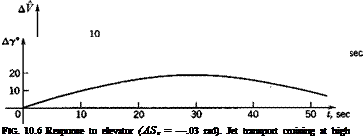RESPONSE TO THE THROTTLE
The initial response of an airplane to movement of the throttle is actually quite dependent on the details of the engine control system and on the type of propulsion system. For jet engines it takes an appreciable time for the rpm and thrust to increase after opening the throttle, and this can be an
 |
important factor in emergency conditions. The response of a propeller, which increases thrust by a change of blade angle, is more rapid. We make the simple assumption here that opening the throttle produces a step change in GT of amount ДGTc. If the thrust line does not pass through the C. G. there is an associated pitching moment (7.3,4) АСШе = АСтг/с. The l. h.s. of the system equation is then exactly the same as (10.2,1) and the r. h.s. is
-1
0
![]()
![]() zjc
zjc
0
APPROXIMATE TRANSFER FUNCTIONS
Since the main effects of the throttle are the long-term changes in speed and flight-path angle, the phugoid approximation to the equations is an
appropriate one. The same procedure that led to (10.2,14) for this case gives the approximate equations
simply leads to a new steady-state flight condition at increased climb angle and no change of speed. By contrast the other principal longitudinal control, the elevator, ultimately influences both speed and flight-path angle [(10.2,16a) and (10.2,17)], albeit the change in the latter may he of either sign depending on flight speed. The simple rule “throttle controls climb and elevator controls speed” is not what it seems. It is true that the throttle is an uncoupled climb control (when г = 0) but the elevator is not an uncoupled speed control (except at ymax) and the rule only applies to steady states, not to initial transients.











